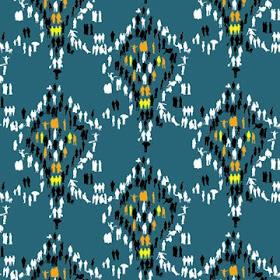I walked into Projects Gallery the other day to deliver some of my artwork, as they are taking my work to a couple of fairs in Miami this weekend, and hanging was their "Paper" show.
The show opens today, which is First Friday for Philly galleries, with an opening reception from 6-9PM. The exhibition continues through December 20th. I have a few pieces in that show, so I wasn't really planning to write anything about it.
But when you first walk into the gallery you see this:

The work all the way on that far wall, seemingly a sort of artist wallpaper at first sight, is one of the most amazing conceptual pieces with a powerful delivery mechanism and one of the most innovative and intelligent works of art that I have ever seen.

Itsuki Ogihara. Population Series. 17”H x 17”W. Digital prints
Like all of you, I was initially fooled by the subject matter macro visual, and it wasn't until I zoomed in and understood what I was seeing, that this young Japanese-born artist (and a student at UPenn I believe) struck me with the powerful punch of that ellusive artistic goal: something new.
Itsuki Ogihara is her name, and this is her latest project (see earlier projects here) and after I describe it for you, I think you will see why I came away so impressed.
Each one of those 17" x 17" digital prints represents an American city. Each "city" has a different design.

Ogihara has taken data from the US Census to determine that city's racial and ethnic demographics, and using an artistic algorithm, she then designs each print to represent that city. The macro design in each city is made up of 100 tiny silhouetted figures in various poses and activities. As an example, in the Salt Lake City print, there are 83 white silhouettes, 2 black, and so on to describe that city's racial and ethnic make-up.

Pretty interesting so far. And then when you study each figure, you realize that they are each individuals. That's right, each individual figure is a separate and distinct image on its own.
What she has done is actually taken hundreds of portraits of people; real people and real photographs, and shrunk them down to the tiny size seen in the prints, and then colored them to represent each race (white for Caucasians, black for African-American, red for Native Americans and yellow for Asians) and one ethnicity (brown for Latinos).
It is such a labor intensive endeavor that it leaves me tired just to think of it. And it is also one of the rare conceptual ideas where the art actually delivers on a par with the idea or wall text about the concept.
Itsuki Ogihara's demographic wallpaper is an unexpected treat delivered in a superbly professional and unique delivery mechanism, which employs concepts of mass production generalization to delve deep into our shared consciousness about race and ethnicity and art.
I see great things in the future of this young artist.